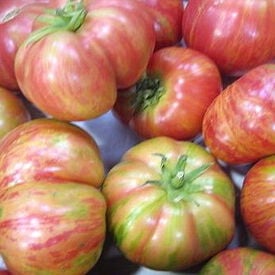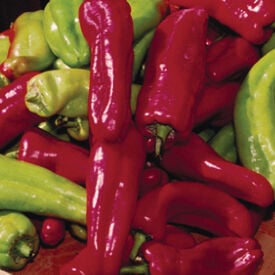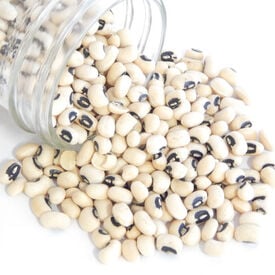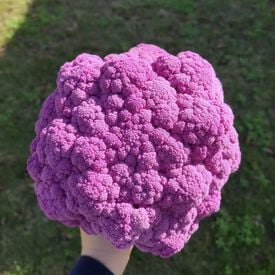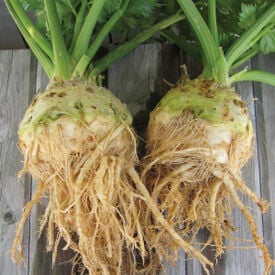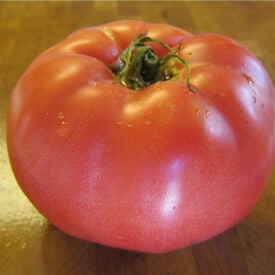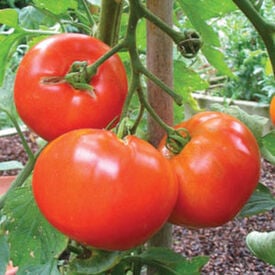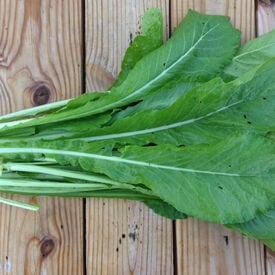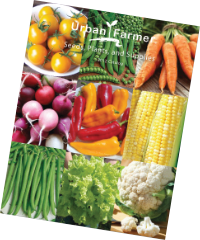The Vintage Wine Tomato is a favorite tomato among gourmet gardeners! This is a wonderful tomato plant to add to your garden as it grows large tomatoes that can reach 1.5 lbs. This variety produces big pink colored tomatoes with golden stripes that have a great tender, sweet and mild flavor. The Vintage Wine plant has potato leave foliage.
The Cubanelle Pepper is a great frying pepper. This 3 lobed pepper is tapered with a blunt end. Its slightly irregular and roughened, medium-thick waxy flesh matures from yellow-green to red, and it has a crispy distinct flavor.
The California Blackeye #46 is similar to California Blackeye #5, but with smaller seeds. Bred by the UCLA and released in 1987. California Blackeye #46 plants are more erect than California Blackeye #5. The seeds are a typical blackeye type of Southern peas with cream-colored seed coats and black pigments around the eyes. Heavy yielder. If using for Nitrogen fixation we highly recommend using a cowpea inoculant. Try with cowpea inoculant for maximum Nitrogen fixation.
The Graffiti cauliflower has a fun purple head with a great flavor! Graffiti produces a true deep purple head. This variety is a large cauliflower plant with dark green leaves and it produces best in the fall. It can also be planted in early spring. The Graffiti is very fun to watch grow and eat!
The Bloomsdale spinach is such an attractive, tasty, and a popular garden standard spinach. This variety is an old favorite amongst gardeners. It has an excellent flavor and produces large quantities of tasty leaves. Bloomsdale is also very nutritious with lots of Vitamin A, C, and iron and is low in calories.
The White Flat Boer Ford is a true white pumpkin that is perfect for autumn displays! This variety grows to be 3 to 5 inches high and spreads 8 to 12 inches wide. This flat pumpkin can weigh between 10 to 15 pounds! The White Flat Boer Ford has deep ribs that makes for an appealing autumn display, but it also has a delicious eating quality for its aromatic, succulent, and sugary flesh.
All of the seeds below are very good at attracting deer to your property! Buckwheat - Improves top soil and an effective choke weed! Plant late spring to early summer. Establishes quickly. Matures in 60 days. Accumulates phosphorus and and potassium for following crops. Frost sensitive. All below packages come in 1lb. bags. Crimson Clover - Winter annual protects and improves soil! Plant fall or early spring. A good nitrogen fixer (70-150 lbs per acre per year). Showy crimson blooms in late spring are an excellent source of nectar for bees. Inter-seeds well with grass. Austrian Winter Pea - A great cool season legume for cover crops, wildlife and winter grazing! Austrian winter pea, sometimes called "black pea" and "field pea" is a cool-season, annual legume with good, nitrogen-fixing capabilities. Austrian winter pea is a low-growing, viny legume which has been shown to fix over 200 pounds of nitrogen per acre per year. Peas - Grow regular old peas in your deer food plot. One of the most preferred vegetables for deer. Oats - Oats will kill off winter weeds and hold soil with a mat of vegetation! A high yielding oat that can produce over 100 bushels per acre. Plant anytime of the year. Deer will graze oats all year round. Barkant Forage Turnip - Great forage crop that provides high energy feed! Barkant turnips are an improved, early maturing, diploid turnip wtih a large purple tankard shaped bulb. Barkant turnips have a high leaf to stem ratio and and provide very high contentrations of protein, sugar content and leaf yields. Barkant Turnips are ideally suited for wildlife. Dwarf Essex Rape - A cabbage related plant that is a perfect grazer! Dwarf Essex Rape is a perfect grazer plant that will persist well after the first frost. Ready to pasture 6-8 weeks after sowing. Hairy Vetch - Sow with or without grain, grass or field peas! When sown late summer, grows fast and will attract wildlife. Hairy Vetch has rapid growth that makes it a good weed suppressant.
The Brilliant celeriac is a large round root related to celery! This celeriac plant produces a a large round root with dark green celery-like leaves and a white flesh. Brilliant is a great addition to any meal as it adds a great flavor!
The Red Beefsteak Tomato produces an extra large, meaty fruit that is very popular among home gardens used for adding to sandwiches other dishes. This beefsteak variety is not grown commercially as often as the smaller types. The Red Beefsteak is describes as being a solid, meaty and juicy tomato that is an excellent slicer.
Florida Broadleaf mustard is a classic Southern heirloom variety long valued for its fast growth, large yields, and reliable performance in warm climates. Originating in the southeastern United States, it produces broad, bright green, smooth-edged leaves that can grow 10–12 inches long, forming an upright, leafy plant about 18–24 inches tall. The leaves are tender yet substantial, with a bold, peppery flavor that mellows pleasantly when cooked. This mustard variety thrives in full sun and prefers rich, well-drained soil with consistent moisture. It grows best in cool to mild temperatures, typically between 50–75°F, making it ideal for spring and fall gardens, though it can tolerate light frosts and brief periods of heat.
The Bradley Tomato is one of the all time Southern favorites! This tomato variety is a reliable, productive plant that has fairly good cover, producing attractive, smooth pink fruit with a tasty mild flavor. Bradley is a disease resistant variety released in 1961 by Dr. Joe McFerran of the University of Arkansas. The seeds produce delicious, sweet tomatoes that are well balanced with just enough acidity to give you that old-fashioned big tomato flavor that you love so much. Bradley tomatoes ripen at the same time making it a great variety for canning and freezing. This variety is suitable for Southern regions, but can grow in most places.
Tendergreen Spinach (Komatsuna) mustard is a prized leafy green known for its mild flavor and tender texture, making it a favorite in both culinary and gardening circles. This variety of mustard greens has its roots in traditional Southern U.S. agriculture, where it has been cultivated for its versatility and ease of growth. Characterized by its large, bright green leaves with a smooth, slightly wrinkled texture, Tendergreen mustard is valued for its mild, peppery flavor that becomes more pronounced when cooked. The plants grow rapidly, reaching maturity in about 40 to 50 days, and are known for their robust, upright growth habit, typically standing 12 to 18 inches tall. They produce small, yellow flowers in early spring if allowed to bolt, though they are primarily grown for their leaves. Tendergreen mustard thrives in cool weather and can be grown in a variety of soil types as long as they are well-drained. The plant’s resilience and quick harvest make it ideal for successive plantings, providing a continuous supply of fresh greens. With its rich flavor, adaptable growing conditions, and rapid growth, Tendergreen mustard is a valuable addition to any vegetable garden.
